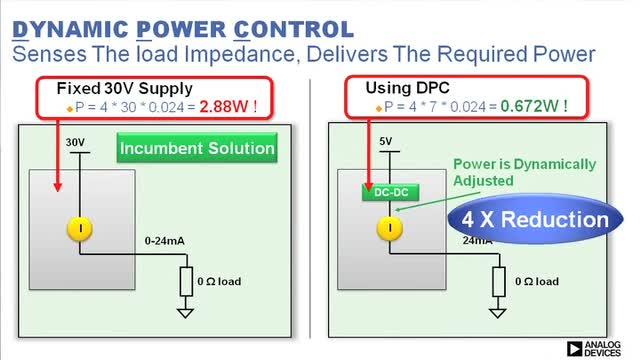AD5737
NOT RECOMMENDED FOR NEW DESIGNSQuad Channel, 12-Bit, Serial Input, 4-20mA Output DAC with Dynamic Power Control and HART Connectivity
- Part Models
- 2
- 1ku List Price
- Starting From $10.51
Part Details
- 12-Bit Resolution and Monotonicity
- Dynamic Power Control for Thermal Management or external PMOS mode
- IOUT Range: 0mA-20mA, 4mA–20mA or 0mA–24mA ±0.1% (TUE) Maximum
- User programmable Offset and Gain
- On-Chip Diagnostics
- On-Chip Reference: ±10 ppm/°C maximum
- −40°C to +105°C Temperature Range
The AD5737 is a quad-channel current output DAC that operates with a power supply range from 10.8 V to 33 V. On-chip dynamic power control minimizes package power dissipation by regulating the voltage on the output driver from 7.4 V to 29.5 V using a dc-to-dc boost converter optimized for minimum on-chip power dissipation.
Each channel has a corresponding CHART pin so that HART signals can be coupled onto the current output of the AD5737.
The AD5737 uses a versatile 3-wire serial interface that operates at clock rates of up to 30 MHz and is compatible with standard SPI, QSPI™, MICROWIRE®, DSP, and microcontroller interface standards. The serial interface also features optional CRC-8 packet error checking, as well as a watchdog timer that monitors activity on the interface.
For a 16 bit equivalent solution, look at the AD5757. For a voltage and current configurable version, see the AD5755, AD5755-1 or AD5735.
Product Highlights
- Dynamic power control for thermal management.
- 12-bit performance.
- Quad channel.
- HART compliant.
Applications
- Process control
- Actuator Control
- PLCs
- HART Network Connectivity
Documentation
Data Sheet 1
Application Note 1
Frequently Asked Question 1
Video 1
Solutions Bulletin & Brochure 1
Device Drivers 1
Analog Dialogue 1
ADI has always placed the highest emphasis on delivering products that meet the maximum levels of quality and reliability. We achieve this by incorporating quality and reliability checks in every scope of product and process design, and in the manufacturing process as well. "Zero defects" for shipped products is always our goal. View our quality and reliability program and certifications for more information.
| Part Model | Pin/Package Drawing | Documentation | CAD Symbols, Footprints, and 3D Models |
|---|---|---|---|
| AD5737ACPZ | 64-Lead LFCSP (9mm x 9mm w/ EP) | ||
| AD5737ACPZ-RL7 | 64-Lead LFCSP (9mm x 9mm w/ EP) |
| Part Models | Product Lifecycle | PCN |
|---|---|---|
|
Sep 23, 2014 - 14_0041 AD5755/AD5735, AD5757/AD5737 and AD5755-1: Change to PEC, Readback Operation and Recommended External Diode |
||
| AD5737ACPZ | ||
| AD5737ACPZ-RL7 | PRODUCTION | |
This is the most up-to-date revision of the Data Sheet.
Software Resources
Device Drivers 1
Evaluation Software 0
Can't find the software or driver you need?
Hardware Ecosystem
| Parts | Product Life Cycle | Description |
|---|---|---|
| ADC/DAC Combo Converters 2 | ||
| AD5700 | PRODUCTION | Low Power HART Modem |
| AD5700-1 | PRODUCTION | Low Power HART Modem with Precision Internal Oscillator |
| Interface Transceivers & Isolators 3 | ||
| ADUM1410 | PRODUCTION | Quad-Channel Digital Isolators |
| ADUM1411 | PRODUCTION | Quad-Channel Digital Isolator |
| ADUM1400 | PRODUCTION | Quad-Channel Digital Isolator (4/0 Channel Directionality) |
| Switching Regulators & Controllers 2 | ||
| ADP2302 | RECOMMENDED FOR NEW DESIGNS | 2A, 700KHz NonSynchronous Step-Down DC-DC Switching Regulator |
| ADP2303 | RECOMMENDED FOR NEW DESIGNS | 3A, 700KHz NonSynchronous Step-Down DC-DC Switching Regulator |
| Voltage References 3 | ||
| ADR02 | PRODUCTION | Ultracompact, Precision 5.0 V Voltage Reference |
| ADR435 | PRODUCTION | Ultralow Noise XFET® Voltage References with Current Sink and Source Capability |
| ADR445 | PRODUCTION | Ultralow Noise, LDO XFET® 5.0V Voltage Reference w/Current Sink and Source |
| Parts | Product Life Cycle | Description |
|---|---|---|
| AD5755-1 | PRODUCTION |
Quad Channel, 16-Bit, Serial Input, 4 mA to 20 mA and Voltage Output DAC, Dynamic Power Control, HART Connectivity |
Evaluation Kits
Latest Discussions
No discussions on AD5737 yet. Have something to say?
Start a Discussion on EngineerZone®


